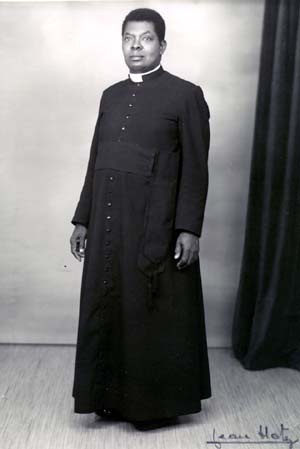Cassock
Cassock, also known as a soutane, is a long, coat-like garment worn by clergy throughout various Christian denominations. The cassock is traditionally black for Roman Catholic clergy, but can be seen in various colors depending on the denomination, rank, or occasion. It is a distinctive form of liturgical clothing and has been a symbol of the clerical state for centuries.
History[edit | edit source]
The origins of the cassock can be traced back to the ancient Roman tunic, which was adapted over the centuries to suit the needs and aesthetics of the clergy. By the Middle Ages, it had become a standard part of the clerical wardrobe. The cassock's design and use have evolved, reflecting changes in fashion, theology, and ecclesiastical authority.
Design and Variations[edit | edit source]
The cassock is generally ankle-length and can be fastened with buttons or a sash known as a cincture. It may have a standing collar or a hood, and sometimes includes shoulder cape, known as a pellegrina, which is particularly associated with the cassocks worn by higher-ranking clergy such as bishops.
Different Christian denominations and even different orders within the same denomination might have specific traditions regarding the color and style of the cassock. For example, in the Roman Catholic Church, a bishop's cassock is usually purple, a cardinal's is red, and the pope's is white. In the Anglican Communion and some Lutheran churches, clergy might wear black cassocks or those of a different color depending on the liturgical season or occasion.
Usage[edit | edit source]
The cassock is primarily a garment for liturgical functions, but it is also worn for everyday activities by some clergy. Its use varies greatly between different Christian traditions. In the Roman Catholic Church, the cassock can be the everyday attire for clergy, though in many places, this has been largely replaced by more modern clerical clothing outside of liturgical functions. In contrast, in many Protestant denominations, the cassock might only be worn for specific services.
Symbolism[edit | edit source]
The cassock serves as a symbol of the wearer's commitment to a life of service to God and the Church. Its uniformity and simplicity are meant to represent the wearer's renunciation of worldly fashion and vanity. The color of the cassock can also hold symbolic meaning, reflecting the wearer's rank, the liturgical season, or specific virtues such as penitence or mourning.
Contemporary Use[edit | edit source]
In contemporary times, the use of the cassock has seen a resurgence in some areas as part of a broader interest in traditional liturgical practices. This is part of a movement in some parts of the Christian world that seeks to reclaim and revitalize ancient traditions and symbols.
See Also[edit | edit source]
Search WikiMD
Ad.Tired of being Overweight? Try W8MD's physician weight loss program.
Semaglutide (Ozempic / Wegovy and Tirzepatide (Mounjaro / Zepbound) available.
Advertise on WikiMD
|
WikiMD's Wellness Encyclopedia |
| Let Food Be Thy Medicine Medicine Thy Food - Hippocrates |
Translate this page: - East Asian
中文,
日本,
한국어,
South Asian
हिन्दी,
தமிழ்,
తెలుగు,
Urdu,
ಕನ್ನಡ,
Southeast Asian
Indonesian,
Vietnamese,
Thai,
မြန်မာဘာသာ,
বাংলা
European
español,
Deutsch,
français,
Greek,
português do Brasil,
polski,
română,
русский,
Nederlands,
norsk,
svenska,
suomi,
Italian
Middle Eastern & African
عربى,
Turkish,
Persian,
Hebrew,
Afrikaans,
isiZulu,
Kiswahili,
Other
Bulgarian,
Hungarian,
Czech,
Swedish,
മലയാളം,
मराठी,
ਪੰਜਾਬੀ,
ગુજરાતી,
Portuguese,
Ukrainian
Medical Disclaimer: WikiMD is not a substitute for professional medical advice. The information on WikiMD is provided as an information resource only, may be incorrect, outdated or misleading, and is not to be used or relied on for any diagnostic or treatment purposes. Please consult your health care provider before making any healthcare decisions or for guidance about a specific medical condition. WikiMD expressly disclaims responsibility, and shall have no liability, for any damages, loss, injury, or liability whatsoever suffered as a result of your reliance on the information contained in this site. By visiting this site you agree to the foregoing terms and conditions, which may from time to time be changed or supplemented by WikiMD. If you do not agree to the foregoing terms and conditions, you should not enter or use this site. See full disclaimer.
Credits:Most images are courtesy of Wikimedia commons, and templates, categories Wikipedia, licensed under CC BY SA or similar.
Contributors: Prab R. Tumpati, MD




